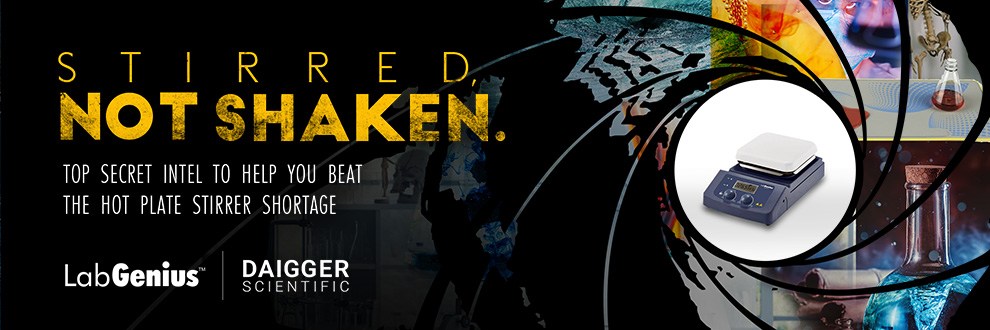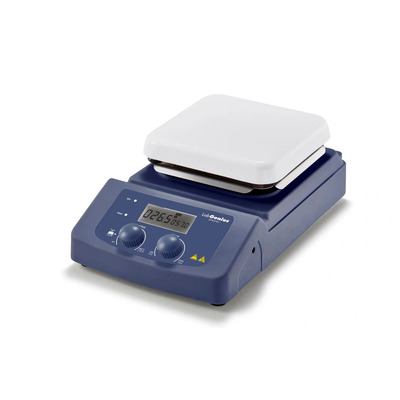What’s the difference between a brand name hotplate stirrer and the brand you’ve never heard of?

And why you don’t need an expensive brand name to do the job well
We’ve all bought for the brand.
Dre’s Beats, arguably the most well-known headphone brand in the world, will cost you upward of $450. Even though they actually cost about $14 to manufacture…Jimmy Choos sell for $800+... And when buying that perfect engagement ring? We pay anywhere from 50% to a whopping 200% more than wholesale costs….
In some industries, maybe the brand matters. Maybe the black Jimmy Choo pumps are worth the markup.
In other industries… in labs and research centers, for example, it’s not the brand that matters. It’s the quality. The precision. The control.
In this article, we compare the difference between expensive brand name hotplate stirrers and lab mats, and more economical house brands. Do they deliver the same results? Let’s find out.
Find out which brand measures up best to the big three
First thing: What’s a magnetic hotplate stirrer?
Magnetic hotplate stirrers are a staple in just about every lab. We’re willing to bet it’s a staple in yours. They can be operated intuitively with everyday laboratory supplies, like Erlenmeyer flasks, flat-bottomed beakers, and stir bars.
How do they work?
Magnetic stirrers mix using a stir bar, coupled to a magnetic drive. This creates a vortex, whose radius and centripetal force depend on:
- The stir bar length
- The speed of rotation
- And the viscosity of the solution it’s mixing
Integrating a hotplate into a stir plate is also convenient. There’s no need for an external heating system (like a flame), a clamp stand or tools.
It sounds so simple! But modern hotplate stirrers have tons of features that can increase safety, quality, speed, and precision. With more user-friendly controls, faster heating, and improved safety measures, users can do far more with magnetic hotplate stirrers today than ever before.
What matters most to users when choosing their hotplate stirrer?
We asked from labs around the world what their top priorities were when it came to their magnetic hotplate stirrers. Three things came up again and again:
- quality
- time
- and price point
One brand delivers on all three
What measures up best against the ‘big brands’?
LabGenius hot plate stirrers are a mid-range house brand from Daigger Scientific. Users who aren’t fussed by the frills of big brand names are choosing LabGenius hotplate stirrers because:
- They’re priced to compete with entry-level models from other manufacturers.
- They’re built with features and performance benchmarks you find in mid-range hot plate stirrers from other brands at twice the price.
Pay a budget price. For a mid-range hot plate stirrer. That’s available right now.
Teams with LabGenius hotplate stirrers in their lab or workplace found that the top things about this instrument are:
- The base is sturdy and the glass ceramic top provides unmatched chemical resistance
- Quick sample heating, which gives them more time for other tasks
- Their space-efficient design, making them ideal for use on crowded benchtops and inside biohoods
- The full speed and temperature control they give users, allowing for quick, precise adjustments and maintenance
An ideal alternative to the big brand names, for users who:
- Prefer a hotplate stirrer that’s nice and quiet while in use
- Have limited workspace, and need a stirrer that fits in narrow spaces
- Need a wide speed range (up to 1500 RPM)
- Require a high temperature range for their sample (choose from a maximum temperature of your heating plate of 380°C or 550°C)

Who is this hotplate stirrer right for?
- chemical synthesis
- physical & chemical analysis
- biopharmaceuticals
For labs seeking a reliable, quality hotplate stirrer that prefer not to spend extra for a big brand name, LabGenius is the ideal alternative.
Choosing a magnetic stir bar
Using a magnetic stirrer is convenient, especially for low viscosity fluid mixing, and requires very little setup. However, stir bars do differ in shape, size, and material. The most common shapes include:
- Round: One of the most common types of stir bars, suitable for various applications, especially with flat-bottomed containers.
- Slide round: These stir bars have a pivoting ring around the center, and are designed to maintain the optimum position in containers with uneven bottoms. The ring helps reduce wear, vibration and friction from contact with the vessel.
- Ellipse (oval): These stirring bars are perfect for homogenous mixing in round-bottomed beakers
- Spherical (ball): Best for small volumes, in containers like test tubes and vials.
- Cross: Good for stability at high speeds. The cross shape provides additional turbulence for better mixing.
- Triangle (prism): These bars provide high turbulence even at low speeds, and the shape can second as a scraper to help dissolve or prevent sedimentation of samples
- Crosshead (crown): Crown-shaped stir bars are great for use in test tubes or cuvettes. They can also be used in other containers, so they’re a good alternative if you need to switch between multiple vessels.
- Bone: This unique shape allows for high amounts of turbulence at low speeds, and provide high stability for containers with arched bottoms
Stir bars consist of two main components: the magnet and the coating. Typically, stir bars are coated with PTFE, which can resist high temperatures. For very high temperature applications, glass-coated options are also available, and a great alternative for use with highly abrasive chemicals.
Best practices to keep in mind when using stir bars include:
- Positioning the container in the middle of the hotplate magnetic stirrer, and placing the stir bar at the centre of the container (to avoid the stir bar catching the side of the container)
- Increasing stirring speed slowly, to avoid spinout
LabGenius hotplate stirrer comes with a single stir bar as a sample. Users who need different shapes or sizes for their application can easily customize their hotplate stirrer by purchasing their own.
Tip: Always ensure you have a couple of backup stir bars on hand, as stir bars are notorious for going missing, rolling off of lab benches, and ending up in unreachable corners.
Top rated accessory: Lab mats
One of the most popular related products users purchase with a hot plate stirrer is a lab mat. These reliable, reusable products are an economical solution to keep benchtops clean and safe from stains, spills and wear.
The most popular choice among users is the Heathrow Silicone Lab Mat. They are easy to clean with any standard disinfectant: simply wipe it down or put it in the dishwasher, and it’s ready to be used again. And they’re designed with a slight lip to contain liquids, and a magnet build-it, to prevent runaway stir bars.
Reviews of the Heathrow Silicone Lab Mat
- Ideal for every type of lab, and for more specialized areas too (like cold rooms, clean rooms, and sterile suites)
- Made from durable FDA-approved silicone material, that creates a stain-resistant, washable surface
- A more environmentally friendly option over disposable mats
- The anti-skid surface keep the mat and items in place
- The noise dampening surface reduces sound from the vibration of common benchtop equipment, making for a more peaceful workday
- The internal magnet keeps stir bars from wandering around the working surface
These Heathrow Scientific Silicone Lab Mats can be used with hot plates and stirrers, centrifuges, vortex mixers, pipettes, and so much more.
Why should you use a temperature probe with a hotplate stirrer?
LabGenius hotplate stirrers are safe and economical, providing uniform heating and quality construction to meet your lab’s rigorous requirements.
Hotplates, and hotplate stirrers, are benchtop laboratory instruments used to heat evenly and mix a wide range of liquids and solutions.
- Conventional hotplates are used for heating only
- Combination stirring hot plates are able to simultaneously heat and mix
Using an external temperature probe with your hot plate stirrer allows for improved accuracy and control of the temperature of your liquid or solution. By submerging the probe into the liquid, you can monitor and control the sample temperature. owever, when a temperature probe isn’t used, the plate itself will heat up to the set temperature of the instrument.
How do you use a magnetic stirrer with a hotplate: Best practices to keep in mind
When using your hotplate:
- Ensure the base is set on a hard surface, like a countertop or table
- Plug the cord into an outlet, then place the beaker, flasks, or other vessel containing your sample on the heated hot plate
- Do not operate the hotplate without a liquid filled vessel on it, and do not let the vessel boil dry
- Once on, make sure you do not touch the heated surface. Make sure you turn of the hot plate after use
When using your magnetic stirrer:
- Drop the stir bar into your solution, and let it settle.
- Turn on the magnetic stirrer by flipping on the power switch. You control the speed of the rotation, to change how fast it spins (and how fast your solution is stirred)
The best magnetic hotplate stirrer alternative to the big brands
LabGenius magnetic hotplate stirrers are a mid-range house brand from Daigger Scientific, and the most popular option among users who want to pay a budget price for a mid-range hotplate stirrer.
Get in touch with Daigger Scientific directly to place your order